CHAPTER TWO: 6.5 MILLION UNUSED NUMBERS IN THE 831 AREA CODE
Of the 7.7 million numbers in the 831 area code, companies hold 3.1 million. The other 4.6 million numbers have not been assigned to companies. The CPUC's utilization study found that 1.9 million of the 3.1 million numbers held by companies remain unused in their inventories. Therefore, 6.5 million numbers in the 831 area code remain unused. All companies, either through pooling or through the monthly lottery allocation process can make a portion of these unused numbers available for use. In addition, companies have reported 1.2 million numbers as unavailable. A portion of these unavailable numbers can be used more efficiently if the recommendations contained in this report are implemented.
A. THE SCOPE OF THE UTILIZATION STUDY
4. Distribution Statistics of Prefixes
The CPUC asked 37 companies, holding 309 prefixes in the 831 area code, to report their utilization data, with a reporting cutoff date of December 31, 2000. Table 2-1 shows the distribution of these prefixes by type of carrier: incumbent local exchange carrier (ILEC), competitive local exchange carrier (CLEC),19 cellular carriers, and paging carriers.
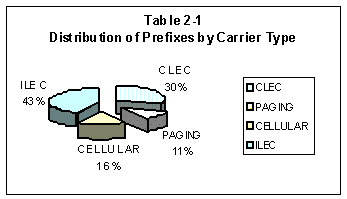
5. Companies Reporting
Of the 37 companies in the 831 area code, 33 submitted utilization data. A list of the companies that have been allocated numbers in the 831 area code appears in Appendix A-2.
6. Non-Reporting Companies
 The remaining four companies hold seven prefixes in the 831 area code. According to NANPA, San Diego Paging, TSR Wireless LLC, Prism California Operations LLC, and Urjet Backbone Network, Inc. are no longer in business in California. Table 2-2 summarizes this information.
The remaining four companies hold seven prefixes in the 831 area code. According to NANPA, San Diego Paging, TSR Wireless LLC, Prism California Operations LLC, and Urjet Backbone Network, Inc. are no longer in business in California. Table 2-2 summarizes this information.
Recommendation for Data Submittal
· The CPUC should direct the NANPA to withhold issuing prefixes to any carrier that has not reported except for those that are out of business until the required information is submitted. The CPUC should also consider levying fines or other penalties for failure to comply. If prefixes are not being used for customers, the CPUC should direct the NANPA to reclaim those prefixes as soon as possible.
A. 6.5 MILLION NUMBERS AVAILABLE IN THE 831 AREA CODE
The 831 area code has about 6.5 million unused numbers. Of these unused numbers, TD found that companies held approximately 1.9 million numbers in their inventories.20 These numbers held in inventory are currently not used for any purpose except for the anticipation of future need. The remaining 4.6 million unused numbers are not yet assigned to companies but are available from the Code Administrator. The 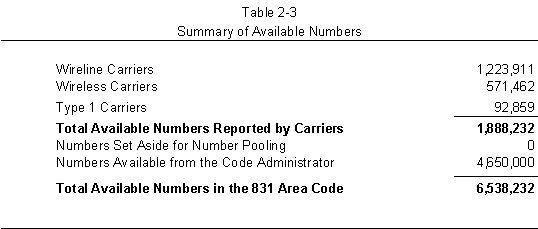 summary of available numbers is shown in the table below.
summary of available numbers is shown in the table below.
Not all of the approximately 6.5 million unused numbers are immediately available to every company that wants numbers. Of the 6.5 million, a maximum of about 5.1 million numbers22 is estimated to be available to all companies. The remaining 1.4 million numbers are only available to the companies that hold them. As shown in the table below, the CPUC could shift the availability of numbers from one category to the other by adopting the recommendations23 in this report. Of the 6.5 million unused numbers, those actions could result in making a maximum of 5.9 million numbers24 available to all companies, with the remaining 0.6 million numbers available to the companies that hold them.
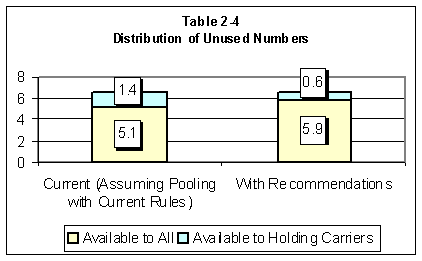
Current technology requires a company to be LNP capable in order to donate numbers for another company to use. All wireline carriers in the 831 area code are required to be LNP capable.25 Wireline carriers hold about 1.2 million unused numbers in the 831 area code. In order for the unused numbers to be retrieved from inventories, the FCC requires these unused numbers to be retrieved from blocks that are 10% or less contaminated.26 Out of all the wireline companies, approximately 0.7 million of their 1.2 million unused numbers are contained in 770 thousand-blocks held by LNP-capable firms and are 10% or less contaminated. However, not all of these 1.2 million numbers can be retrieved from companies' inventories because companies need to have enough numbers to meet anticipated future need.27
Both the CPUC and the FCC have determined that six months of inventory is a reasonable quantity to hold for future use. TD will not know how many of these 1.2 million numbers will be available for pooling until companies identify their pooling block donations to the pooling administrator. Pooling in the 831 area code is tentatively scheduled for fall 2002.28 In the meantime, a reasonable estimate of numbers likely to be donated to the 831 pool, based on the experience of the 310 pool, is 1.2 million29. The difference between the potential maximum of 0.7 million currently pool-able numbers that wireline carriers hold and the approximately 0.4 million numbers to be donated to the pool consists of about .3 million numbers that companies will need for their six-month inventories.
Therefore, about .5 million of the 1.2 million unused numbers cannot be retrieved, either because the numbers are in blocks more than 10% contaminated or because they are in non-LNP-capable blocks. However, companies can immediately use these numbers to provide service to their customers or meet other needs. Wireline carriers hold about 298,000 numbers in blocks that are more than 10% contaminated.30 Wireline carriers hold approximately another 169,000 unused numbers in blocks that are non LNP-capable. Wireless carriers hold approximately 571,000 unused numbers in the 831 area code. Of these unused numbers from wireless carriers, about 424,000 are in blocks that are 10% or less contaminated and about 147,000 numbers are in blocks more than 10% contaminated but less than 25% contaminated. Until wireless carriers become LNP capable in November 2002, none of these numbers may be reallocated to other companies. In the interim, wireless carriers may assign these numbers to their own customers.
B. ANALYSIS OF AVAILABLE NUMBERS
1. Analysis of Wireline Carriers' Contamination Rates
The CPUC requires each company participating in number pools to donate blocks that are 10% or less contaminated, excluding those retained for the company's six-month inventory.31 TD analyzed the 831 utilization data to determine the availability of numbers within blocks of different contamination rates in order to assess various contamination thresholds. The following table summarizes available numbers by contamination level and rate center for wireline carriers.
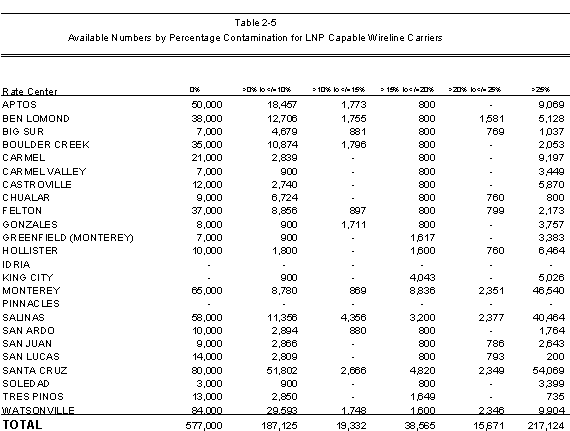
The first two numeric columns of Table 2-5 show the potential numbers available to the future number pool, except for those numbers kept for the companies' six-month inventory, under current rules. Available numbers in one rate center cannot be used in another rate center. Table 2-5 shows that all rate centers except for Idria and Pinnacles have available numbers that could be donated to the pool. The last three columns of Table 2-5 capture available numbers in blocks that are more than 10% contaminated but no more than 25% contaminated. Under the current rules for number pooling, companies retain thousand-number blocks that are more than 10% contaminated. Increasing the contamination rate threshold for donations from 10% to 25% would potentially free up 74,00032 more numbers for use in the number pool. TD cautions that, although Table 2-5 shows potential results from increasing allowable contamination levels, further analysis and input from the industry would be necessary to accurately determine the quantity of additional blocks that could be added to the pool while still leaving companies with a six-month inventory.
As shown by Table 2-5, and also shown graphically in Table B-3 of Appendix B, most rate centers have available numbers from blocks of differing contamination levels up to 25%. The tables show that if the contamination ceiling for pooling were increased from 10% to 25%, more unused numbers could exist in all rate centers that potentially would be donated to the pool.
Recommendation from Block Contamination Analysis of Wireline Carriers
· The CPUC should petition the FCC to increase the contamination level for pooling to 25%. If the FCC grants the petition, the CPUC should increase the maximum contamination level of donated blocks from 10% to 25% for all LNP-capable carriers.
2. Analysis of Wireless Carriers' Contamination Rates
Under current FCC rules, cellular and PCS companies are exempt from number pooling until November 2002 when they must become LNP capable. The FCC has indefinitely exempted paging companies from becoming LNP capable. Since the FCC has granted wireless carriers a time extension to implement LNP technology, no wireless carriers serving the 831 area code are capable of implementing LNP. Thus, wireless carriers cannot participate in number pooling at this time, resulting in about 571,000 unused numbers in blocks with contamination levels between 0% and 25%. Table 2-6 shows the available numbers in blocks of various contamination levels held by wireless carriers.
Wireless carriers also have about 79,000 available numbers in blocks with contamination levels greater than 10% but less than or equal to 25%, as indicated by the last three columns of Table 2-6. Of these 79,000 unused numbers held by wireless carriers, TD estimates that 42,000 (53%) are held by paging companies33. TD staff is investigating whether there are methods to make some of these 42,000 unused numbers available to other carriers despite the FCC's exemption of paging companies from the LNP requirement.
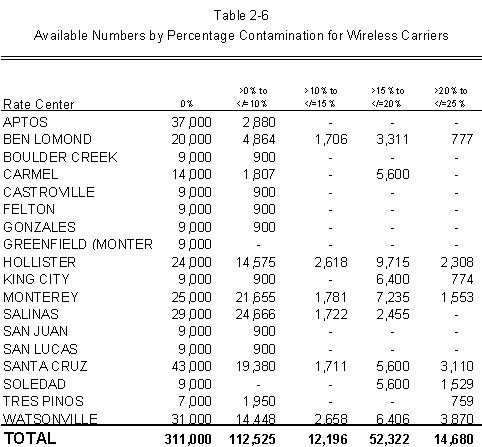
Further analysis of the utilization data submitted by wireless carriers reveals sharply differing utilization rates of paging carriers and cellular/PCS companies. Paging carriers' data shows a utilization rate of only 2% numbers (counting assigned numbers only) while cellular/PCS carriers in the 831 area code are using 39% of their total numbers held. Paging carriers reported an additional 6% of their numbers used for administrative, intermediate, reserved, and aging purposes, yielding a total percentage of unavailable numbers of 8% out of total numbers held. Cellular/PCS carriers reported 8% of their numbers used for these miscellaneous purposes, bringing their total percentage of unavailable numbers to 47% out of total numbers held. Therefore, 92% of the numbers held by paging companies are unused, while 53% of the numbers held by cellular/PCS carriers are unused.
Recommendations from Block Contamination Analysis of Wireless Carriers
· When cellular and PCS companies become LNP capable in November 2002, the CPUC should direct those wireless carriers to donate to and participate in all number pools in California, using the same contamination threshold for donated blocks in effect for all LNP-capable companies.
· The CPUC staff should meet with paging companies to explore options for their consolidating numbering resources in fewer rate centers, as well as other methods of reducing the number of stranded numbers held by paging companies.
3. Potential Block Contamination Abuses
When blocks are slightly more than 10% contaminated, those blocks cannot be donated to a pool under current pooling rules. Viewing the utilization data suggests that some companies have consistently not followed practices of sequential numbering and filling blocks substantially before using new blocks.
The CPUC's rules on sequential numbering and fill rate practices promulgated in Decision 00-07-052 are designed to ensure that companies efficiently use their numbers in the future. Fill rates mitigate contamination by requiring companies to use contaminated blocks up to 75% before they can receive additional blocks or prefixes. Sequential numbering minimizes contamination by requiring companies to begin assignment in the next thousand-block only after a 75% fill rate has been attained in the prior block. Where companies possess significant available numbers in a given rate center, these two efficiency measures could prevent the opening of new blocks or prefixes.
Companies reported utilization data as of December 31, 2000. The sequential numbering and fill rate decision was issued in July 2000. Some of these practices of non-sequential numbering and not filling blocks substantially before using new blocks may have happened before the July 2000 decision. However, TD does not expect companies to continue contaminating blocks unnecessarily.
Recommendation for Block Contamination Issues Affecting All Carriers
· The CPUC should monitor compliance with its fill rate and sequential numbering policies through future number utilization filings and audits.
· The CPUC should establish penalties for non-compliance with fill rate and sequential numbering policies adopted in Decision 00-07-052.34
4. Reclamation of Prefixes
Decision 00-07-052 directed companies to return prefixes that are held unused for more than six months. As shown in Appendix B-1, wireline carriers and wireless carriers hold 718,000 unused numbers and 311,000 unused numbers, respectively, in 0% contaminated blocks. Of these unused numbers, 300,000 are in 30 whole prefixes35 that are completely uncontaminated, i.e., spare prefixes, while 729,000 numbers are in uncontaminated blocks that are scattered throughout many different prefixes. The following table shows the breakdown between wireless and wireline carriers.
The 300,000 numbers in 30 spare prefixes can possibly be reclaimed if not used within six months. However, as a result of the FCC's March 31, 2000 (first) NRO Order, the NANPA no longer has sole authority to reclaim unused prefixes. The FCC granted authority to state regulatory commissions to investigate and determine whether prefix holders have activated their prefix (es) within the allowed time frames, and directed NANPA to abide by the state commission's determination to reclaim a prefix if the state
commission is satisfied that the prefix holder has not activated their prefix (es) within the time specified in the first NRO Order.36 Substantial cooperation between the CPUC and NANPA will be required in order for the CPUC to exercise this new authority and determine whether a prefix should be reclaimed. Furthermore, NANPA must still perform the mechanical steps to reclaim prefixes once the CPUC directs NANPA to reclaim a prefix.
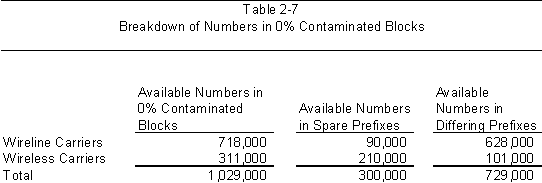
NANPA has provided to the CPUC a list of companies that have failed to report whether their assigned prefix (es) has been placed in service. The CPUC issued Assigned Commissioner's Ruling Requiring Carriers to Comply With NXX Code Reclamation Rules, dated December 21, 2000. In this ruling, the CPUC instructed the delinquent companies to comply immediately. Companies are to inform the CPUC either that the prefix (es) has been placed in service or returned, or the company was incorrectly included in the NANPA's delinquent list, and the reasons the prefix (es) has not been placed in service. The CPUC will review the reasons and make a determination as to whether the prefix (es) must be returned or reclaimed by the NANPA, or whether to grant an extension of time for the company to place the prefix (es) in service. Any delinquent company that fails to comply will be subject to penalties and sanctions.
C. ANALYSIS OF 1.2 MILLION UNAVAILABLE NUMBERS
In the following sections, TD recommends a series of policies designed to require companies to use unavailable numbers more efficiently. These policies would potentially free more numbers for use in the future 831 number pool, to be assigned to carriers from Code Administration, or to be used otherwise by companies. Companies reported that 1.2 million numbers in the 831 area code are either assigned to customers or are used by companies for reserved, administrative, intermediate and aging purposes. Telephone companies commonly refer to these numbers as "unavailable." However, based on the FCC's description of unavailable numbers, it also includes the following categories:
· Reserved numbers - Numbers that are reserved in blocks for future use by specific customers;
· Administrative numbers - Numbers that companies use for their own internal purposes;
· Intermediate numbers - Numbers that are made available for use by another telecommunications carrier or non-carrier entity for the purpose of providing telecommunications service to an end user or customer; and
· Aging - Numbers from recently disconnected service, which are not reassigned during a fixed interval.
In its first NRO Order, the FCC ruled that companies must show that they have used a certain percentage of their existing inventory of numbers before they may obtain additional numbers in a given rate center. This order specified that companies' utilization rates will be calculated using only assigned numbers in the numerator. This method greatly increases companies' incentive to use numbers sparingly for purposes of reserved, administrative, intermediate, or aging numbers; none of those uses will raise a company's utilization rate and enable it to obtain additional numbers.
1. 886,000 Assigned Numbers
In the 831 area code, there are about 886,000 assigned numbers, with approximately 687,000 assigned to customers by wireline carriers and 199,000 assigned to customers by wireless carriers. The percentages of assigned numbers to total numbers held by companies are shown in the table below.

a. Non-Working Wireless
Non-Working wireless numbers describes numbers assigned to wireless customer equipment, but which are not yet working. These numbers are considered a sub-category of assigned numbers. For example, wireless carriers sometimes pre-package a cellular telephone with an assigned telephone number for sale to customers. Although the number is assigned, it will remain inactive until a customer purchases the telephone. Companies did not report any non-working wireless numbers in the 831 area code. While the quantity of reported non-working wireless numbers is currently zero, this sub-category of assigned numbers could increase because there are no restrictions on the number of days that a wireless company can hold these numbers thus, causing numbers to remain idle for an unspecified period.
The CPUC should consider several options to improve inventory management of non-working wireless numbers. One option is for the CPUC to require companies to return these numbers to the available category after 180 days (similar to the requirement the FCC has established for reserved numbers). Another option is for the CPUC to require companies to maintain inventory records of all such retail/wholesale equipment with the associated numbers assigned while requiring regular (weekly/monthly) updating of these inventory records since pre-packaged equipment with non-working assigned numbers is often located in various retail outlets.
Recommendations for Treatment of Non-Working Wireless
· Non-working wireless numbers should be treated as reserved numbers and limited to 180 days then they should be classified as available for assignment to customers.
· Companies should be required to regularly maintain and update their inventory records of all equipment assigned non-working wireless numbers along with the number assigned, and to submit such records to the CPUC upon request.
· The CPUC should continue to monitor non-working wireless numbers in the near term by reviewing future utilization filings, and should include this category of numbers in any audits conducted of wireless carrier number use.
b. Eliminating Interim Number Portability Releases Numbers for Reallocation
Interim Number Portability (INP) is the ability to move telephone service from one service provider to another using Remote Call Forwarding (RCF), Direct Inward Dialing (DID), or equivalent means. 37 Prior to the implementation of permanent LNP, companies entered into INP arrangements to enable the transfer of customers from one company to another. Under these INP arrangements, two telephone numbers are associated with each customer. LNP eliminates the need for two telephone numbers for each customer when the customers change companies because customers can take their numbers with them. Since portions of the 831 area code are included in the top 100 MSAs in the nation, wireline carriers should be LNP-capable in some of the area code. Nonetheless, there were three INP numbers reported in the 831 area code. TD questions why any INP numbers exist in this area code since LNP replaced INP.
Recommendations for INP-Related Conservation Measures
· The CPUC should require companies to transition from INP to LNP in the 831 area code and implement a monitoring mechanism to ensure compliance.
· The CPUC should adopt a schedule for transitioning INP arrangements to LNP in all other California area codes.
c. Expanded Use of the 555 Prefix Could Release Other Prefixes Dedicated to Special Uses
Historically, the telecommunications industry has designated certain prefixes for special uses, usually to an ILEC. These include numbers for recorded public information announcements such as time-of-day, weather forecasts, high-volume call-in numbers, and emergency preparedness38 numbers. These prefixes are not available for general commercial use thus, numbers within these prefixes that are not in actual use lie vacant. In 1999, companies decided not to duplicate the special use prefixes in each area code. Concerned that this process could adversely affect the public, the CPUC directed that these prefixes should be duplicated in each new area code. The utilization study shows that 5 prefixes in the 831 area code are dedicated for special use: one each for directory assistance, time, emergency preparedness, and two for high-volume calling. TD questions the necessity of assigning an entire prefix for each of these purposes.
Furthermore, having multiple special use prefixes is an inefficient use of numbers in the 831 area code as well as in other area codes in California. For example, if the 555 prefix 39 currently reserved only for directory assistance could be used to provide time and emergency preparedness, then two more prefixes could be returned for reallocation in the 831 area code. Similarly, expanded use of the 555 prefix throughout the state could result in more returned prefixes in other area codes. TD recommends that the CPUC initiate an investigation into broader uses of the 555 prefix in California. The CPUC should further analyze the option of obtaining standard 555 numbers in every California area code to provide time, emergency preparedness, and weather information at no additional cost to customers.
Recommendations for Special-Use Prefixes
· TD recommends that the CPUC initiate an investigation into the possibility of moving the numbers for time and emergency preparedness into the 555 prefix.
· TD recommends that the CPUC include in its investigation the broader use of the 555 prefix in California's area codes by providing standard 555 numbers in every California area code to provide time, emergency preparedness, and weather information.
2. Reserved Numbers Are a Potential Source of Additional Numbers
Carriers "set aside" numbers for future use by customers.40 Previously, industry number assignment guidelines allowed companies to reserve a prefix for up to 18 months for customers' future use.41 The FCC's first NRO Order modified the number reservation period to 45 days.42 The second NRO Order changed the number reservation period to 180 days. This requirement took effect on December 29, 2000.43
Companies reported a total of 212,500 reserved numbers in the 831 utilization study. 44 Wireline carriers reported a total of 51,178 reserved numbers in the 831 area code. If the quantity of reserved numbers held by wireline carriers can be minimized then additional numbers could be available for immediate use by the companies from within their own number inventories, thus slowing the rate at which new prefixes are allocated to these companies. Numbers could also be freed up for reallocation in the future 831 number pool. Currently there are no limitations on the quantity or percentage of numbers a company can classify as reserved before requesting new numbers. Similarly, companies are not required to use their reserved numbers stock before they can request that new numbers be allocated to them. Comparing the data on the wireline carriers in the Ben Lomond rate center and Boulder Creek rate center illustrates wide discrepancies between the quantity of reserved numbers that companies hold. Each rate center has eight prefixes and eight service providers, yet Ben Lomond has 1373 reserved numbers and Boulder Creek only has 445. Ordering efficient practices specific to reserved numbers would free up more numbers for customers to use.
Wireless carriers reported 15,091 reserved numbers in the 831 area code. They also reported wide variances in reserved numbers. Comparing the data on the Ben Lomond rate center and the Carmel rate center illustrates wide discrepancies between the quantity of reserved numbers that companies hold. Carmel has three prefixes and 2000 reserved numbers while Ben Lomond has four prefixes and only 69 reserved numbers. Just as for wireline carriers, efficient practices specific to reserved numbers could free up numbers within these companies' inventories thus, slowing the rate at which new prefixes are allocated to these companies. Once wireless carriers are able to participate in number pooling, these practices could have the same efficiency gains as for wireline carriers.
Recommendations for Reserved Numbers
· The CPUC should monitor usage of reserved numbers for all companies by reviewing future utilization data to ensure companies are complying with the FCC's 180-day requirement.
· The CPUC should adopt efficient number use practices specific to companies' reserved number holdings. In developing these practices, the CPUC should investigate various alternatives including, but not limited to, 1) limits on the quantity or percentage of reserved numbers companies can hold, and 2) requirements for using reserved numbers prior to requesting new numbers.
3. Restrictions on Administrative Numbers Could Yield More Numbers
Administrative numbers are not assigned to customers and are generally used for a wide range of applications for companies' internal use, including testing, internal business, and other network purposes. Companies reported about 65,000 administrative numbers in the 831 area code. Wireline carriers hold approximately 60,000 of these numbers and wireless carriers hold approximately 5,000 numbers.45 The utilization study revealed that companies may over-assign administrative numbers within a particular thousand block, prefix or rate center in the 831 area code. The following example demonstrates the potential for over-assignment. In the Salinas rate center, a company is using 252 numbers for administrative purposes in one prefix while the average across all companies is between 0 to 100. Given the variances in the levels of administrative numbers between companies and rate centers, it is unclear what basis companies use for placing numbers in this category. The CPUC should therefore pursue an investigation in this area.
In addition, some companies randomly assign administrative numbers and are thereby wasting number resources. Companies could conserve numbers by centralizing assignment of administrative numbers within one or a few blocks in one prefix. However, some companies randomly assigned administrative numbers in multiple thousand-blocks within the same prefix. Already, companies have contaminated multiple thousand-blocks thus, preventing them from donating blocks once they can participate in number pooling or other LNP-based conservation measures because of this practice. Also, some companies holding multiple prefixes in a given rate center randomly assign administrative numbers throughout different prefixes when they have the available number resources to centralize the assignment of these numbers in one prefix in that rate center.
TD questions the need for companies to hold multiple prefixes in a given rate center when they are using multiple prefixes to serve their internal purposes and not necessarily to serve customers' needs. This practice means that both wireline and wireless carriers will already have contaminated multiple thousand-blocks and prevents them from donating blocks once they can participate in number pooling, or from other LNP-based conservation measures. As stated in section D above, under the utilization rules promulgated in the FCC's First and Second NRO Orders, carriers now have a much stronger incentive to minimize the quantity of numbers they use for administrative purposes, thus freeing more numbers for intermediate assignment to customers or for donation to the number pool.
Recommendations for Administrative Numbers
· The CPUC should develop criteria by which companies assign administrative numbers. The CPUC should consider placing a limit on the quantity or percentage of administrative numbers companies are allowed to hold.
· The CPUC should develop rules that require companies to limit administrative number assignments within certain blocks in a given prefix. In cases in which companies hold multiple prefixes in a single rate center, the CPUC should develop rules that require companies to limit administrative number assignments within prefixes.
4. Intermediate Numbers
The "intermediate number" category was only recently introduced by the FCC in its first NRO Order. This category tracks numbers that companies make available for use by another telecommunications carrier or non-carrier entity. Companies reported a total of approximately 217,000 intermediate numbers in the 831 area code. Wireline carriers hold about 195,000 of those numbers and wireless carriers hold about 22,000. The quantity of intermediate numbers varied significantly among rate centers in the 831 area code. 46 Since the intermediate number category is new, the quantity of numbers reported by companies may increase over time, as more companies become familiar with this category. TD notes that this number use category has the potential for abuse by companies if they use significant quantities of number resources for intermediate purposes. Therefore, TD recommends the CPUC continue to monitor intermediate numbers.
Recommendation for Intermediate Numbers
· The CPUC should monitor intermediate number use for all companies by reviewing future utilization filings to test whether potential abuses in this reporting category occur.
a. Type 1 Numbers
Wireline carriers allocate numbers for use by wireless carriers through Type 1 interconnection agreements.47 Because wireline and wireless carriers share responsibility for Type 1 numbers, both types of companies reported on these numbers. Wireline carriers report Type 1 numbers in the intermediate category since they provide these numbers to another company. Wireline carriers also list the wireless carriers to whom they distributed ranges of numbers. Wireless carriers report on the numbers they received, placing them in the assigned, administrative, reserved, intermediate, aging, or available categories.
Generally, record keeping of Type 1 numbers is inadequate because the wireline carriers' reports disagree with wireless Type 1 carriers' reports. In the 831 area code, over half of all Type 1 numbers are unaccounted for or mismatched.48 In some cases, wireless Type 1 carriers deny "owning" the numbers that wireline carriers' report as distributed. In other cases, wireless Type 1 carriers go out of business and do not return their numbers to the wireline carrier. In either case, numbers are lying dormant, used by neither the wireline or wireless Type 1 carrier.
In today's scarce numbering environment, it is unacceptable to let numbers go unused because of inadequate record keeping. Wireline donor carriers currently do not monitor wireless Type 1 inventories, nor do they proactively reclaim unused Type 1 numbers from wireless carriers. TD recommends that wireline carriers perform a one-time inventory check on Type 1 numbers to confirm that the numbers they have distributed are acknowledged by the recipient wireless Type 1 carrier. If errors are discovered, the wireline carriers should count the numbers as part of their own inventories.
Improved Type 1 number management is particularly crucial because unlike numbers held by most wireless carriers, Type 1 numbers are eligible for number pooling.49 Therefore, once wireline carriers recover unused Type 1 numbers, these numbers could be made available for pooling. Despite the problems with reporting, TD has identified 4 blocks of Type 1 numbers in the 831 area code that may be eligible for donation to the pool.50 The CPUC should recognize Type 1 numbers as a resource for number pooling and take steps to have wireline companies recover unused Type 1 numbers for donation to the number pool.
As described in Chapter 1, state and federal mandates require most companies to demonstrate efficient numbering practices before becoming eligible to obtain more numbers. In contrast, Type 1 wireless carriers have no check on their number use because they draw numbers directly from wireline companies thereby avoiding the scrutiny of the official number administrator. TD recommends that Type 1 wireless carriers be subject to number conservation measures, and the CPUC should develop a system to ensure compliance.
Recommendations for Type 1 numbers:
· Wireline and wireless carriers should improve Type 1 number inventory management. Wireline carriers should perform a one-time inventory check of wireless Type 1 numbers to verify their records match that of the wireless Type 1 carriers' records. Companies should make inventory data available to the CPUC upon request. Wireline carriers should recover and add to their inventories any Type 1 numbers lying dormant.
· Type 1 carriers should be subject to number conservation techniques such as sequential numbering and fill rates. A system to ensure compliance with Type 1 number conservation measures should be developed.
· The Commission should consider Type 1 numbers as potential donations to the number pool. Excess and unused Type 1 numbers should be returned to the wireline carriers and either used to serve customers or donated to the number pool.
5. Aging Numbers
The FCC's first NRO Order defines aging numbers as disconnected numbers that are not available for assignment to another customer for a specified period of time. Consistent with the Industry Numbering Committee (INC) Guidelines, the CPUC adopted the FCC upper limits for aging numbers as 90 days for residential numbers and 365 days51 for business numbers. In the 831 area code, there are approximately 59,000 numbers in the aging category, representing 4.59% of the total unavailable numbers. A higher percentage of aging numbers occurs in the wireless category, compared to the wireline category. Aging numbers represent 6.33% or 16,000 numbers of the total unavailable wireless numbers. Aging numbers represent 4.15% or 43,000 numbers of the total unavailable wireline numbers. This is consistent with the higher turnover or "churn" that occurs in the wireless industry. Table G-1, in Appendix G, shows the breakdown of aging numbers by wireless and wireline categories.
Recommendation for Aging Numbers
· Although the CPUC has required all companies to differentiate aging numbers between residential and business, and track the two categories separately, Pacific Bell has not complied with these requirements. Pacific Bell should be redirected to differentiate aging numbers between business and residential, track them separately, and report on each category accurately. The CPUC should assess penalties for failure to comply.
6. The Need to Audit the Data
The data analyzed in this utilization study was self-reported by companies. Given the area code crisis in California, the CPUC should audit this data for two reasons. First, verifying number usage data is important to ensure that the public resource of telephone numbers is efficiently managed. Second, audits will help verify whether companies are complying with CPUC and FCC rules for number usage.
Recommendation for Audit
· The CPUC should audit the data submitted by companies in this study and any future area code number utilization study.
